Guppy Disease: Beginners Medical Playbook
This guppy disease guide will help you identify the illness your guppy might have and will help you treat it.
If your guppy is sick now- help us make this resource better by sending us a short email with its symptoms and some pictures. The more guppy disease pictures we have- the better this resource will be for everyone.
Table Of Contents
- Guppy Ich
- Guppy Fin Rot
- Guppy Dropsy
- Guppy Velvet Disease
- Guppy Columnaris
- Guppy Mouth Fungus
- Guppy Swim Bladder Disorder
- Guppy Flukes
- Guppy Gill Disease
- Guppy Hole In The Head
- Guppy Lice
- Guppy Tumors
- Guppy Anchor Worms
- Guppy Fungal Infections
- Guppy Popeye
- Guppy Parasites
- Guppy Constipation
- Ammonia Burns
- Stress-Related Disease
- Can’t find an answer? Tell us about your case!
1)Guppy Ich (Ichthyophthirius Multifiliis)
Highly Common
How common is the issue
Parasite Infection
What causes the disease
How to Identify Guppy Ich
- White spots resembling grains of salt on the fish’s body, fins, and gills.
- Lethargy
- loss of appetite
- rubbing against objects.

What Causes This Guppy Disease- Ich
Stress and Poor Water Quality: Stress, caused by overcrowding, sudden environmental changes, and poor water quality (high ammonia, nitrites, or fluctuations in temperature and pH), will weaken your guppies’ immune systems, opening the door for the parasite.
Introduction of Infected Sources: Ich can be introduced through new guppies carrying the parasite, contaminated equipment, or unquarantined plants and decorations. Proper quarantine procedures and equipment maintenance are essential to prevent this.
Lack of Proper Care and Treatment: Overfeeding, overcrowding, and transport stress can all lead to your guppy developing ich.
How To Treat Ich In Guppies
The first thing you want to do is to isolate the sick fish and move it into a separate tank or bowl.
Then, raise the water temperature to around 82-86°F (27-30°C) and use medications containing active ingredients like copper-based treatments or formalin. Here are a couple of exmaple of what you can use:
Copper-based treatments: Examples include CopperSafe and Cupramine. These medications effectively target the ich parasite.
Formalin: Formalin-based treatments like Quick Cure and ParaGuard can also be used to treat ich and other external parasites.
Malachite Green: This chemical is found in medications like Rid-Ich Plus and can be used to treat ich.
Always follow the manufacturer’s instructions when using any medication and consider consulting with a veterinarian or experienced aquarist for specific guidance on dosages and treatment duration for your guppy tank.
How To Prevent Guppy Ich
Maintain optimal water conditions
the easiest, most streamlined way to maintain water conditions in your guppy tank is to change about 20 to 50 percent of the water about once a week.
To make sure the parameters are within range, use a testing strip and test the water regularly. You might discover your water quality drops below acceptable levels sooner than your once-a-week mark. This will mean you’ll need to find the source of what causes your water quality to drop.
Avoid Sudden Temperature Fluctuation
Guppies thrive in water temps of 78-82 F. (while anything between 72-84 is considered livable, temp too high/low might open the door for disease). You also want to avoid a water temp change of more than 1 degree every 24 hours.
Quarantine New Fish
The way that the parasite will end up in your tank in the first place is because it can from the outside world.
the parasite piggyback off new fish or decoration found in the wild and not quarantined.
That is a big reason why I recommend to only get plants and fish from stores and reputable sellers instead of hunting your own.
2) Fin Rot In Guppies
Fairly Common
How common is it?
Bacterial Infection
What causes the illness
How To Identify Guppy Fin Rot
- Fins appear tattered, frayed, or disintegrating.
- In severe cases, the infection can extend to the fish’s body.

How To Treat Guppy Fin Rot
To treat this guppy disease, you have to improve water quality through regular water changes and maintain stable conditions.
Then, you’ll use antibiotics such as Maracyn, Maracyn 2, or Tetracycline to treat the infection.
Follow the medication’s instructions for dosage and treatment duration. Remove any severely damaged fins to prevent further spread of the disease, and ensure proper nutrition and a stress-free environment to aid in the healing process.
How To Prevent Guppy Fin Rot
Maintain Clean Water Conditions
When I say clean water conditions I mean parameters that fall in the following guidelines:
Ammonia: 0
Nitrate: below 20ppm
Nirtite: 0
pH levels: between 7-8
Water Temp: 78-82f (25-28C)
You achieve those when you:
Perform Regular Water Changes
You should be doing a 20-50% water change about once a week. That will help remove and balance out the tank and keep toxins to a minimum.
Use a testing strip to test your water and make sure your paramteres are within good levels. If you see that your water isn’t lasting a week then you may need to address the reason it is happening.
For example, your pH can be off 3 days after a water change. In that case, you’d look at what is swaying your pH levels and work on that.
Avoid Overcrowding
This one is quite simple- the more fish in the tank the higher the chance your fish might get a physical injury.
Remember to have about 1 gallon per guppy, so a 10 gallon tank should only have up to 10 guppies in it.
3) Guppy Dropsy
Fairly Common
How common is the issue
Bacterial Infection
What causes the illness
How To Identify Guppy Dropsy
- Bloated appearance.
- Scales standing out like a pinecone.
- Loss of appetite.
- Lethargy.
- Swollen eyes.
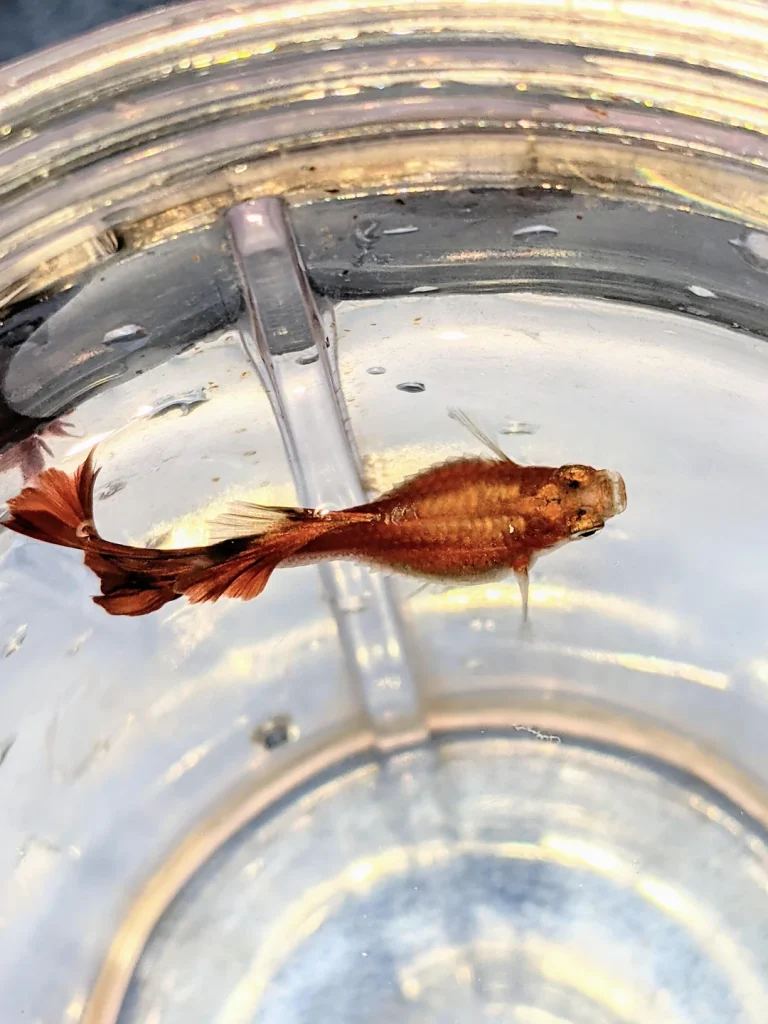
How To Treat Guppy Dropsy
Here’s the thing- dropsy is curable, but not always. I’m not saying don’t get your hopes up, but be realistic. Whether it makes it or not will simmer down to the condition and the guppy’s age
Remove your sick fish and place it in a separate bowl. Use antibiotics such as:
- Erythromycin
- Kanamycin
- Nitrofurazone
Maintain pristine water quality with regular water changes and ensure a balanced diet.
Dropsy can also be associated with organ failure, so treatment may not always be successful. While I have seen cases of dropsy make a 180 and have a full recovery, I’ve also seen cases that haven’t.
How To Prevent Guppy Dropsy
Follow these 3 steps to address your guppy’s dropsy.
Provide Clean Water
For the most part, you’ll need to:
Change about 20 – 50 percent of the water on a weekly basis.
Test the water regularly using a testing strip to monitor quality. I would test the water every 3 days to make sure the results are consistent. If you see big sways in between results you’ll need to find the source of the problem and address it.
For example: if you find that you have high levels of nitrate in your tank in between testing you’ll need to address your nitrate problem.
Avoid Overfeeding
Overfeeding leads to uneaten food settling to the bottom of the tank and rotting.
That leads to higher levels of ammonia, which is harmful to guppies- mainly because it reduces their ability to fight other diseases.
Only feed your guppies enough food for them to eat in 20 to 30 seconds, twice to 3 times a day.
Maintain Good Filtration
Good filtration can be done by getting the right biofilter. It’s job is to suck in the ammonia and turn it into nitrate which your plants and fish can use.
P.S.
You can dive deeper into the topic without guppy dropsy guide.
4) Guppy Disease - Velvet Disease
Common
How common is the issue
Parasitic infection
What causes the illness
How To Identify Guppy Velvet Disease
- Yellowish or gold dust-like particles on the fish’s skin, fins, and gills.
- Scratching against objects.
- Rapid breathing.
- Loss of appetite.
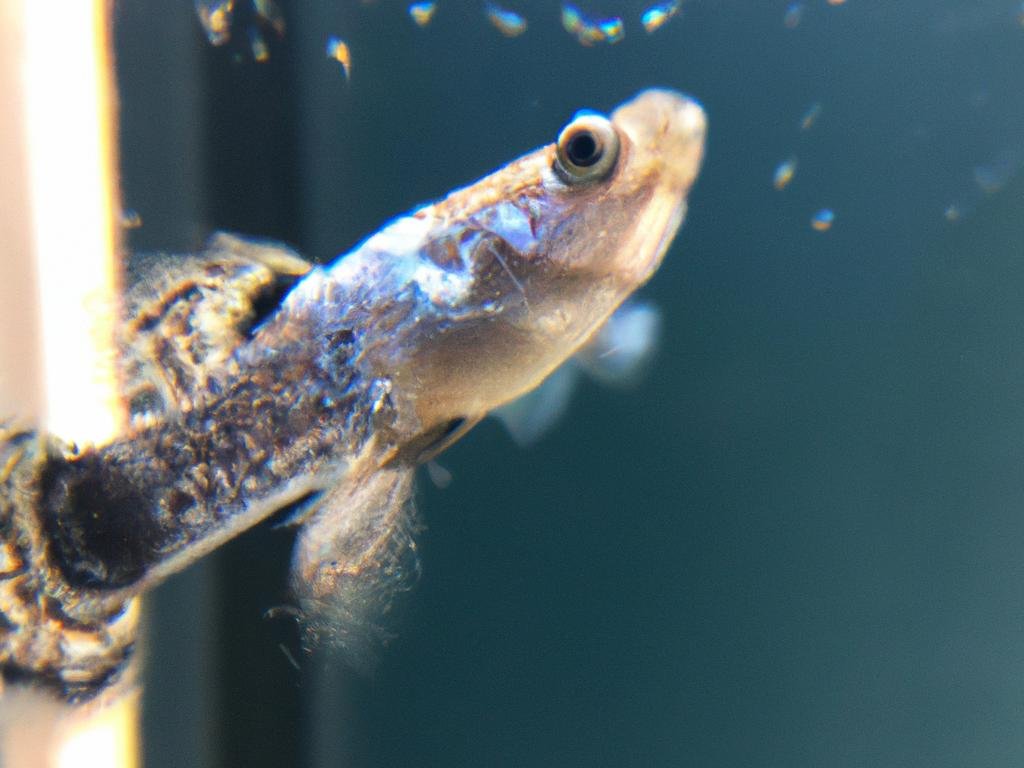
How To Treat Guppy Velvet Disease
To treat guppy velvet disease, also known as Piscinoodinium or Gold Dust disease, you can use medications such as CopperSafe, Copper Power, or formalin-based treatments like Quick Cure.
Isolate the affected fish in a quarantine tank, raise the water temperature to around 82-86°F (27-30°C), and follow the medication instructions carefully.
I’ll state the obvious and say you want to ensure good water quality with regular water changes and provide a stress-free environment. Proper nutrition and a balanced diet can also support the fish’s recovery.
How To Prevent Velvet Disease In Guppies
Maintain Stable Water Conditions
I would ensure consistent temperature and water quality by using a reliable heater and thermometer, along with a good-quality filter.
Regular water changes of about 20-50% every one to two weeks help keep ammonia, nitrite, and nitrate levels in check. You want to get in the habit of testing your water regularly using a testing strip. That will tell you if your tank has an underlying issue and where it is.
Quarantine New Fish
The way that the parasite will end up in your tank in the first place is because it can from the outside world.
the parasite piggyback off new fish or decoration found in the wild and not quarantined.
That is a big reason why I recommend to only get plants and fish from stores and reputable sellers instead of hunting your own.
Avoid Stress
Truth be told, doesn’t take much to stress guppies out.
They can freak out because of water temps, an algae bloom, or overcrowding.
To control these, avoid drastic water changes (like we mentioned before).
To control algae, either get algae eaters, like snails, or limit the amount of light your tank gets.
We’ve talked about overcrowding a lot, so I’ll just leave you with the 1 guppy per gallon ratio in mind.
5) Guppy Columnaris
Common
How common is the issue
Bacterial infection
What causes the illness
How To Identify Guppy Columnaris
- White or gray patches on the fish’s skin, fins, or mouth.
- Ragged or eroded fins.
- Loss of appetite.
- Lethargy.
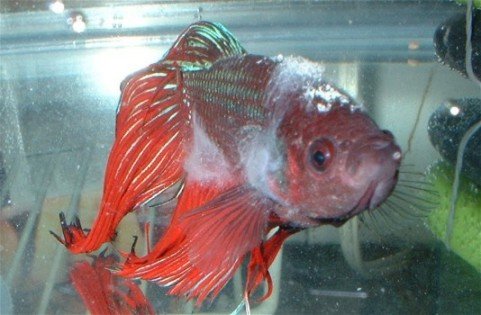
How To Treat Guppy Columnaris
To treat guppy columnaris, also known as Cotton Wool Disease, you can use antibiotics such as
- Maracyn,
- Maracyn 2
- Kanamycin
After you isolate the affected fish in a quarantine tank to prevent further spread of the disease, follow the medication’s instructions for dosage and treatment duration.
You also want to ensure excellent water quality through regular water changes and provide a stress-free environment with proper nutrition.
If the condition worsens despite treatment, consulting a knowledgeable fish health expert or veterinarian may be necessary.
How To Prevent Columnaris
Guppy Columnaris is typically the result of stress and poor water quality.
Here are a few steps to bring your tank back to where it needs to be.
Provide Clean Water
Clean water to fish is like oxygen to us. Your best best is change up to 50 percent of your guppies water about every week to 10 days. Using a testing strip to test the parameters will dictate when you need to do a water change.
for reference, here are the parameters you’re looking for:
Ammonia: 0
Nitrate: below 20ppm
Nitrite: 0
pH levels: between 7-8
Water Temp: 78-82f (25-28C)
Avoid Overcrowding
As we’ve already mentioned before, guppies are high susceptible to stress.
As a rule of thumb, you should have abut 1 guppy per gallon in the tank.
When you evaluate your aquarium, remember to consider plants and decorations. If those are taking up a big portion of your tank- your tank may be overcrowded.
Maintain Good Filtration
Good filtration can be achieved by using a good biofilter. Make sure your pump is sized to make your tank at a minimum rate of 6 times an hour.
That means that if you have the common 10-gallon tank, then you’d need a 60-gallon per hour pump to keep up.
another way to “filter” your tank is by introducing shrimp and snails.
They may not be really filtering the tank like a biofilter and pump do, but they’ll be working to eat waste and algae- and make the filters job way easier.
6) Guppy Mouth Fungus
Common
How common is the issue
Bacterial or fungal infection
What causes the illness
How To Identify This Guppy Disease
- White or gray cotton-like growth around the mouth, lips, or fins.
- Loss of appetite.
- Difficulty eating.
- Visible inflammation.

How To Treat Guppy Mouth Fungus
The first thing you want to do is isolate your fish. This guppy disease can be contagious and spread to other tank mates.
Then, you can use antifungal medications like Methylene Blue, Acriflavine, or an antibiotic-fungicide combination like Furan-2.
As part of your treatment, you want to maintain excellent water quality through regular water changes and provide a stress-free environment along with a balanced diet.
If the condition persists or worsens despite treatment, consulting with a fish health expert or veterinarian is advisable.
How To Prevent Guppy Mouth Fungus
Guppy Mouth Fungus is usually the result of poor water conditions or physical injuries.
Maintain clean water conditions
Here are a couple of things you can do to help keep clean water conditions:
- Filter and heater- make sure your filter and heater are working properly. You need to clean your filter once a month and replace its biofilter element around the same time.
- Regular water changes– change about 20 to 50 percent of your tank’s water about once a week
- Use a testing strip to test the water parameters. If there’s an underlying problem in the tank- this test will be able to illuminate it.
Avoid Overfeeding
Overfeeding leads to uneaten food settling to the bottom of the tank and rotting. Unless you have shrimp or any other type of bottom feeders, that food ends up rotting on the bottom of the tank.
That leads to higher levels of ammonia and other toxins that lead to weakened immune system.
Only feed your guppies enough food for them to eat in 20 to 30 seconds, twice to 3 times a day.
Prevent Physical Injuries
Your guppies can be getting physically injured because of 2 main reasons:
Overcrowding and the wrong decorations.
If your tank is overcrowded, whether with too many guppies and other fish or because plants and decorations are taking too much of the tank’s volume then your guppies may get injured.
Another reason is using the wrong substrate or decorations- mainly ones with sharp edges that guppies may rub against.
7) Guppies Swim Bladder Disorder
Common
How common is the issue
Various factors
What causes the illness
How To Identify Guppies Swim Bladder Disorder
- Difficulty swimming or maintaining balance.
- Floating at the surface or sinking to the bottom.
- Loss of appetite.

How To Treat Guppy Swim Bladder Disorder
When I treat swim bladder disorder the first thing I do is test for constipation. This is usually the case.
To treat constipation:
Move the fish into a new, temporary tank or bowl. Add about 1 to 3 teaspoons of Epson salt per gallon of water. I would switch the fish’s diet to peas- those are known to help push stuff out.
If you see no change in 3 days, try withholding food for another 3 days. another thing you can do, assuming you have a second heater, is heat up the quarantine tank’s water to 78-82 degrees. The hotter water will help push constipation out.
How To Prevent Guppy Swim Bladder Disorder
Guppy swim bladder disorder can result from overfeeding, constipation, genetic predisposition, or bacterial infections. Follow these steps to try and mitigate the problem.
Provide A Varied Diet
Your guppy may not be responding well to the food you’re giving.
You should feed your guppies food specifically designed for tropical fish, ideally for guppies.
If you are feeding your guppy goldfish food– this may be the culprit.
You can also supplement their diet by giving them live food, like brine shrimp or daphnia.
Alternatively, you can make a blend of blanched spinach or kale.
Avoid Overfeeding
Overfeeding may lead your guppy to eat way more than needed.
Unfortunately, guppies will often overeat which can lead to both minor and major issues.
A good rule of thumb is to only feed them enough food for them to eat in about 20 to 30 seconds, 2 to 3 times a day.
Maintain Good Water Quality
Provide your guppies with clean water by monitoring your water levels for toxins like ammonia, nitrite, and nitrate.
To monitor those levels, use a testing strip.
You also need to mitigate algae, either by getting snails, shrimp, and plants or by adjusting the amount of light your aquarium receives.
8) Guppy Flukes
Common
How common is the issue
Parasitic flatworms
What causes the illness
How To Identify Guppy Flukes
- Scratching against objects
- Flashing
- Excessive mucus production.
- Clamped fins
- Lethargy
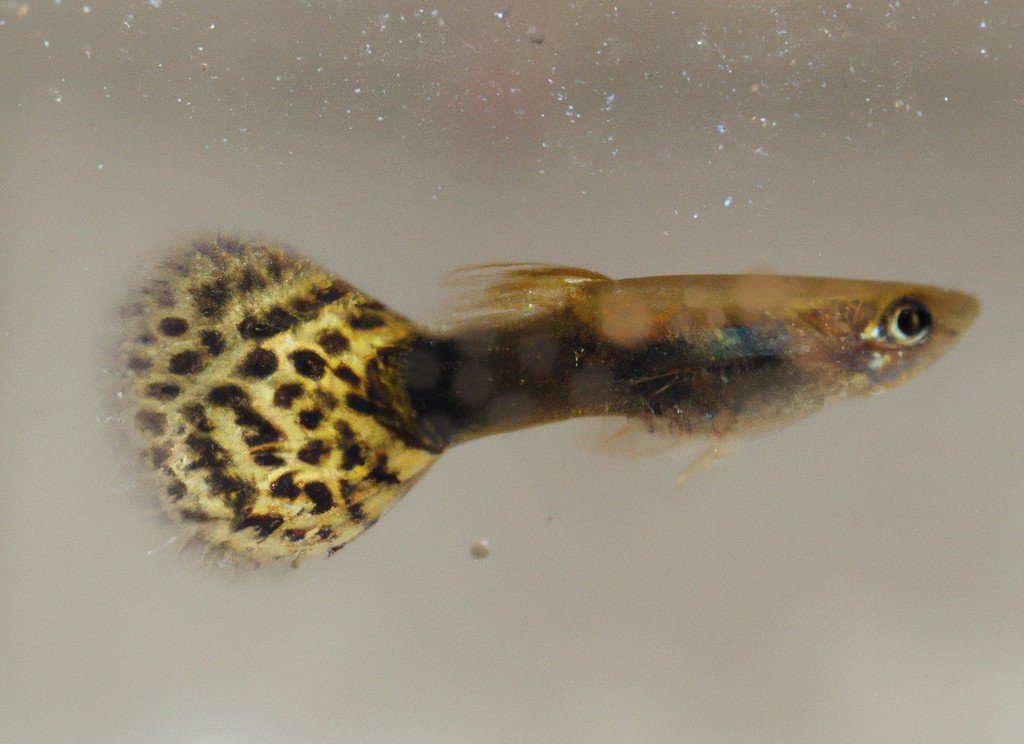
How To Treat Guppy Flukes
To treat guppy flukes, medications containing praziquantel, such as PraziPro, are effective in eliminating these parasitic flatworms.
Make sure to follow the instructions on the medication label for proper dosage and treatment duration.
You also want to isolate the infected fish in a quarantine tank and maintain good water quality through regular water changes and aeration.
Gravel vacuuming can also help reduce the risk of reinfestation. Consult with a knowledgeable fish health expert or veterinarian if the condition persists or worsens despite treatment.
Flukes- How To Prevent This Guppy Disease?
Quarantine New Fish
I’ll talk mostly about fish bought from mainstream sources- like fish stores and online sellers. The process is similar for fish from the wild (like ponds and rivers) but will require a lot more quarantine time than captivity fish.
All you have to do is set up a separate tank and let the new fish live there for about a week. Feed as usual, but look for any signs of illness. The best way to set up a tank like that is to use some “seasoned” water from the main tank.
Maintain Good Water Quality
- Perform regular water changes. This is the most important thing you can do to keep your tank water clean and healthy for your fish. Aim to change 20-50% of the water every week or two, depending on the size of your tank and the number of fish.
- Use a good filter system. A filter helps to remove waste products and debris from the water, and it also provides oxygen to the fish. Make sure to clean your filter regularly according to the manufacturer’s instructions.
- Don’t overfeed your fish. Uneaten food can decompose and pollute the water. Feed your fish only as much food as they can eat in 2 minutes, and remove any uneaten food after that time.
- Test your water regularly. This will help you to identify any potential problems with the water quality early on. You can test your water for pH, ammonia, nitrite, nitrate, and other important parameters.
Avoid Overstocking
Overcrowding a tank can lead to this guppy disease for 2 reasons:
1) The new additions may be carriers for the parasite. They may not show any symptoms, but other fish can have a weaker immune system and develop flukes.
2) Overcrowding leads to stress, which leads the a weaker immune system in fish.
9) Guppy Gill Disease
Common
How common is the issue
Bacterial or parasitic infection
What causes the illness
How To Identify This Guppy Disease Affecting Its Gills
- Labored or rapid breathing.
- Gasping at the water’s surface.
- Inflamed or discolored gills
- Decreased activity.
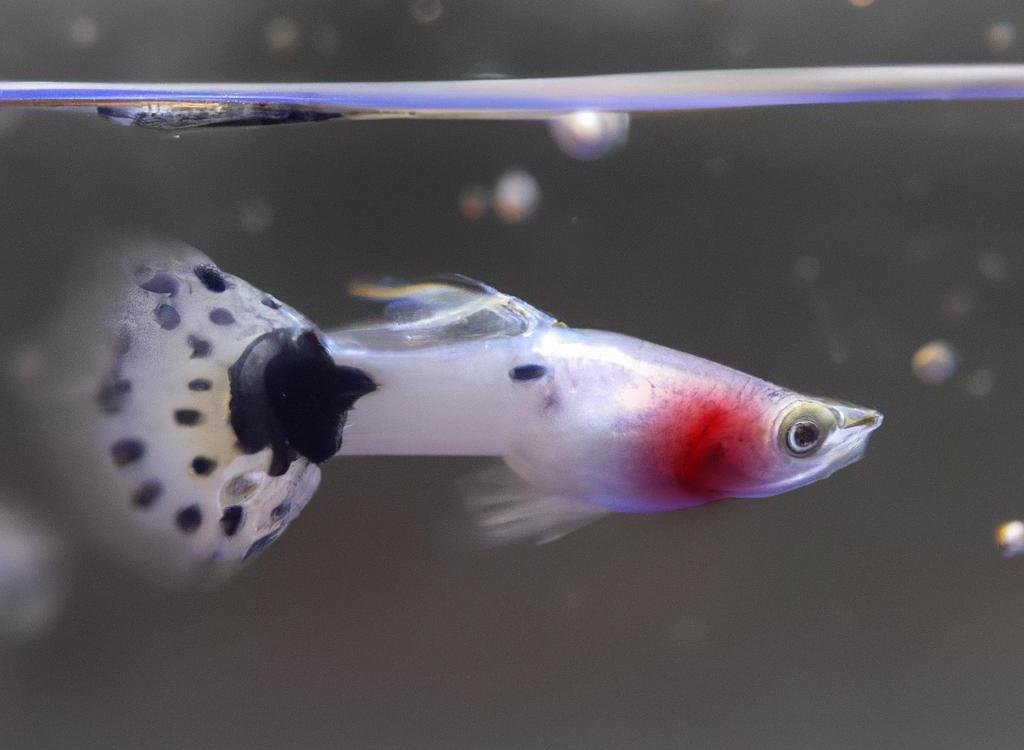
How To Treat Guppy Gill Disease
The best way to tackle guppy gill diseases is to use antibiotics like erythromycin or kanamycin.
You’ll want to isolate the affected fish in a quarantine tank and follow the medication instructions for dosage and treatment duration.
Also, ensure excellent water quality through regular water changes and provide a stress-free environment with proper nutrition. guidance.
How To Prevent Guppy Gill Disease
Since guppy gill disease is usually rooted in poor water quality, follow these steps to correct the tank’s water.
Maintain Clean Water Conditions
There are 3 simple ways to keep your guppies’ water in top condition:
Avoid overfeeding- as the residue will sink to the bottom of the tank and will turn the water ugly.
Regular water changes- replace about 20-50% of the water about once a week. If your fish are coming down with guppy diseases often then test your water quality using a testing strip every 3 days to troubleshoot the problem.
Just as a reference, the right guppy water parameters are:
- Ammonia: 0
- Nitrate: below 20ppm
- Nitrite: 0
- pH: 7-8
- Temp: 78-82
Provide Proper Aeration
- Invest in an aquarium air pump and air stone to create bubbles and promote water circulation. This helps increase oxygen exchange at the water’s surface.
- Position the air stone near the tank’s water surface to maximize the oxygenation effect. You can attach it to a suitable spot or use a suction cup to keep it in place.
- Adjust the airflow of the air pump to achieve the desired level of aeration. You can regulate it using the control valve or adjust the air pump’s settings.
- Keep an eye on the air bubbles and ensure they are evenly distributed throughout the tank. This helps prevent stagnant areas and ensures adequate oxygen supply to all areas.
- Regularly clean the air stone and air pump to prevent blockages and maintain optimal performance.
Avoid Sudden Temperature Fluctuations
Use a reliable heater: Invest in a high-quality aquarium heater with a built-in thermostat to maintain a stable water temperature. Set it to the desired temperature suitable for guppies and regularly monitor its functionality.
Avoid placing the tank near temperature extremes: Keep the tank away from direct sunlight, drafts, air conditioning vents, or heating sources. These external factors can cause rapid temperature changes and stress your guppies.
Gradual temperature adjustments: When you need to change the water temperature, do so gradually over a period of time. Sudden temperature shifts can shock your guppies and lead to stress or health issues. Use a thermometer to monitor the water temperature during the adjustment process.
10) Guppy Hole-in-the-Head Disease (Hexamitiasis)
Fairly Common
How common is the issue
Parasite
What causes the illness
How To Identify Guppy Hexamitiasis
- Small pits or holes on the fish’s head.
- Reduced appetite
- Weight loss
- Lethargy
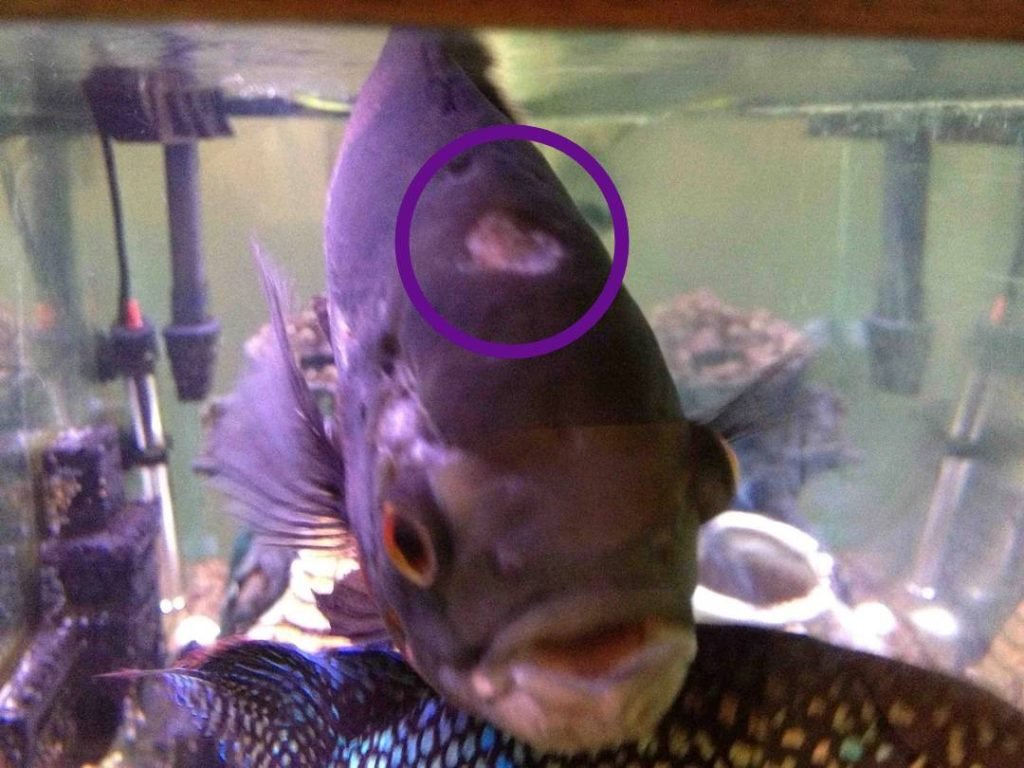
How To Treat Guppy Hole-In-The-Head
There are a few different ways to treat guppy hole in the head disease. The most common treatment is to use a medication called metronidazole. Metronidazole is a broad-spectrum antibiotic that is effective against many different types of parasites, including the one that causes hole in the head disease.
A few more things you can do are:
- Perform regular water changes to maintain good water quality.
- Feed your guppy a high-quality diet.
- Avoid adding any new fish to your tank until your guppy is fully recovered.
How To Prevent Hole-In-The-Head
Preventing hexamitiasis in guppies is possible by ensuring the water in the tank are in tip-top condition, along with feeding your fish a diverse diet to help them fight illnesses.
Maintain Optimal Water Conditions
Keeping the water quality in your guppy fish tank top-notch is vital for their well-being. Here are some easy tips to maintain good water quality:
Test the water regularly using a test kit to monitor ammonia, nitrite, nitrate, and pH levels. This helps you catch any issues early on.
Perform regular partial water changes of around 20-30% every one to two weeks to remove accumulated waste and toxins.
Clean the tank’s substrate, decorations, and filter media periodically to prevent the buildup of debris and organic matter.
Avoid overfeeding your guppies as excess food can lead to ammonia spikes. Feed them only what they can consume within a few minutes.
Invest in a reliable filtration system suitable for your tank size and maintain it properly by cleaning or replacing filter media as needed.
Remember, maintaining good water quality is key to your guppies health.
Avoid Overfeeding
Here’s why you shouldn’t go overboard with feeding your guppies!
Overfeeding can lead to waste buildup, leading to poor water quality, and potential health issues.
Plus, uneaten food can break down and pollute the tank, creating a mess and increasing the risk of bacterial or fungal growth.
It can also lead to bloating and constipation- 2 problems that require fixing on their own.
Provide a Varied Diet
Here are a few tips about providing a diverse diet to your guppies:
Mix up their main meals: Offer a combination of high-quality flakes and pellets specifically formulated for guppies. This provides essential nutrients and helps maintain their overall health.
Add some live or frozen treats: Treat your guppies to occasional live or frozen foods like brine shrimp, daphnia, or bloodworms. These provide additional protein and mimic their natural diet, satisfying their predatory instincts.
Include veggies for a balanced diet: Don’t forget about the greens! Offer blanched veggies like spinach, peas, or zucchini as a source of fiber and essential vitamins. It’s a great way to keep their diet diverse and promote overall well-being.
11) Guppy Lice
Fairly Common
How common is the issue
External Parasites
What causes the illness
How To Identify Guppy Lice
- Visible parasites resembling small, flat insects attached to the fish’s body, fins, or gills.
- Scratching against objects and irritation.
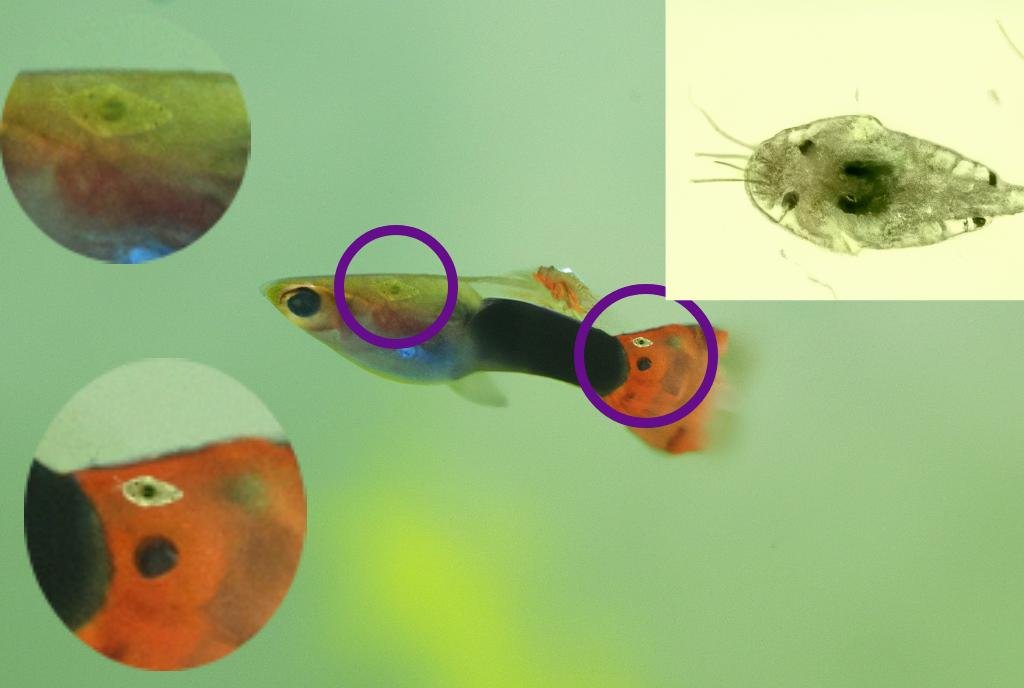
How To Treat Guppy Lice
The first thing you want to do when you are treating this guppy disease is to isolate your fish.
Then, the most common treatment for guppy lice disease is Dimilin. You can get it from most pet stores or online. Follow the instructions on the medication label carefully.
And then you can also use:
- Salt baths: Dissolve 1 teaspoon of aquarium salt in 1 gallon of water and place the guppy in the salt bath for 5-10 minutes, then return it to the main tank.
- Malachite green: Follow the instructions on the medication label carefully.
How To Prevent Guppy Lice
Lice isn’t much of a guppy disease as much as it’s a parasite. Guppy lice get in your tank in the first place for one reason- infected fish or plants.
If you find something in the wild- don’t put it in your tank right away.
You can also circumvent parasites like lice by only buying supplies and fish from reputable suppliers.
Quarantine New Fish
Set up a separate quarantine tank: Prepare a separate tank with its own filtration system, heater, and decorations. This will provide a controlled environment for the new fish and minimize the risk of introducing parasites to your main guppy tank.
Observe and monitor: Keep the new fish in quarantine for a period of at least two weeks, closely observing their behavior and health. Look for any signs of illness, parasites, or abnormal behavior during this observation period.
Treat if necessary: If you notice any signs of parasites or illness, consult with a veterinarian or fish expert to determine the appropriate treatment. Follow their guidance and administer the recommended medication or treatment to address any potential issues before introducing the fish to your guppy tank.
Maintain Good Water Quality
Let’s dive into how to maintain great water quality in your guppy fish tank!
Firstly, test the water regularly using a reliable aquarium test kit to monitor parameters like ammonia, nitrite, nitrate, pH, and a thermometer for temperature.
Perform regular partial water changes, replacing about 20-30% of the water, to remove accumulated waste and toxins.
Don’t forget to clean the tank’s substrate, decorations, and filter media to prevent the buildup of organic matter.
Also, ensure proper filtration by regularly cleaning or replacing filter media to keep the water clean and clear.
Finally, avoid overfeeding your guppies, as uneaten food can contribute to water pollution
Perform Regular Tank Maintenance.
- Perform regular water changes (around 20-30% every one to two weeks) to maintain optimal water quality and remove accumulated waste.
- Monitor and adjust water parameters (ammonia, nitrite, nitrate, pH) regularly using a test kit, and take corrective actions if necessary.
- Clean the tank and decorations periodically to prevent the buildup of debris about once a week.
- Provide proper filtration to ensure effective removal of waste and toxins from the water.
- Keep an eye on your guppies’ behavior and health, watching for any signs of illness or distress.
- Maintain an appropriate water temperature of 78-82 F and ensure the tank is properly heated if necessary.
12) Guppy Tumors
Fairly Rare
How common is the issue
Genetics
What causes the illness
How To Identify Guppy Tumors
- Visible abnormal growths on the fish’s body, fins, or organs.

How To Treat Guppy Tumors
In some cases, surgical removal of tumors may be an option- but usually, those scenarios only exist in the imagination.
When it comes to tumors, its best to prevent them than treat them. I will say that I’ve seen “tumors” go away in pregnant guppies.
What will happen is a female will be very due but the water quality will not be good enough for her to give birth. In this scenario, she’ll hold the fry inside her until she develops tumor-looking bulges.
It might be a long shot, but I would try to do a 10-minute bath of 80-84 degree water with Epson salt (1 teaspoon per gallon) for a couple of days to see if there’s a difference.
How To Prevent Guppy Tumors
You can’t really prevent tumors from growing altogether, but you can stall their growth by providing ideal water conditions.
Maintain Good Water Quality
Keeping the water quality in your guppy fish tank top-notch is vital for their well-being. Here are some easy tips to maintain good water quality:
Test the water regularly using a test kit to monitor ammonia, nitrite, nitrate, and pH levels. This helps you catch any issues early on.
Perform regular partial water changes of around 20-30% every one to two weeks to remove accumulated waste and toxins.
Clean the tank’s substrate, decorations, and filter media periodically to prevent the buildup of debris and organic matter.
Avoid overfeeding your guppies as excess food can lead to ammonia spikes. Feed them only what they can consume within a few minutes.
Invest in a reliable filtration system suitable for your tank size and maintain it properly by cleaning or replacing filter media as needed.
Remember, maintaining good water quality is key to your guppies health.
Minimize Stress Levels
Provide hiding spots: Include plenty of plants, decorations, and caves in the tank to give your guppies places to retreat and feel secure. This helps reduce stress caused by constant exposure.
Maintain stable water conditions: Keep water parameters within the appropriate range and avoid sudden fluctuations in temperature, pH, and water hardness. Consistency in water conditions helps guppies adapt and reduces stress.
Avoid overcrowding: Ensure sufficient space for your guppies by avoiding overstocking the tank. Overcrowding can lead to increased competition, aggression, and stress. Follow recommended stocking guidelines for a harmonious environment.
Offer a varied diet: Provide a balanced diet with a variety of high-quality foods to meet their nutritional needs. This helps prevent nutritional deficiencies and promotes overall health, reducing stress levels.
Minimize disturbances: Limit sudden loud noises, vibrations, and excessive handling around the tank to minimize stress. Guppies are sensitive to their surroundings, and a calm environment promotes their well-being.
13) Anchor Worms
Fairly Common
How common is the issue
Parasitic Worms
What causes the illness
How To Identify This Guppy Disease
- Visible worms attached to the fish’s body, fins, or gills.
- Redness, inflammation, and irritation.
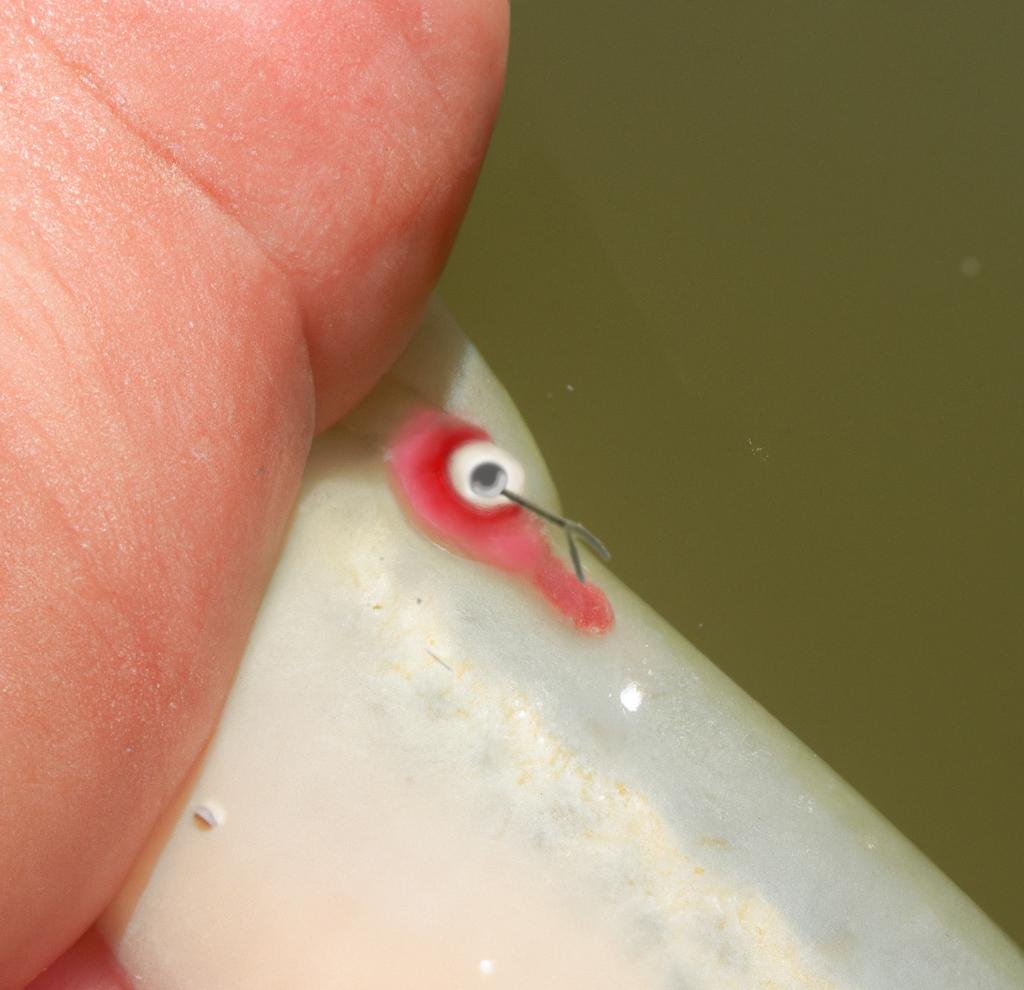
How To Treat Guppy Anchor Worms
There are a few different medications and treatments you can use to treat guppy parasitic worms. The most common treatment is to use a medication called Levamisole. Levamisole is a broad-spectrum antiparasitic that is effective against many different types of parasites, including the ones that cause parasitic worms in guppies.
Other treatment options:
- Praziquantel
- Fenbendazole
- Flubendazole
Please note: It is important to follow the instructions on the medication label carefully. Some medications may require multiple doses or water changes.
Additional tips:
- Feed your guppy a high-quality diet to help them stay healthy.
- Maintain good water quality by performing regular water changes.
- Quarantine any new fish before adding them to your main tank.
If you are unsure which treatment is best for your guppy, it is always best to consult with a veterinarian or experienced aquarist.
How To Prevent Guppy Anchor Worms
The only way to introduce foreign worms into your tank is by adding infected plants or fish.
Exercise caution when considering introducing items from the wild into your tank.
To prevent parasite infestations, only allow supplies and fish bought from reputable suppliers.
Quarantine New Fish
The best way to avoid parasites is to avoid introducing things (be it fish, plants, or rocks) from nature.
If you must (mainly because you want to) then you’ll need whatever item to “live” in a demo tank for a couple of days before introducing it.
Set up a quarantine tank by borrowing some tank water from your main tank and placing the new addition in that tank. Care for it (whether it’s a fish or a plant) for and allow it to live in the quarantine tank for about 3-7 days.
Maintain Good Water Quality
Let’s dive into how to maintain great water quality in your guppy fish tank!
Firstly, test the water regularly using a reliable aquarium test kit to monitor parameters like ammonia, nitrite, nitrate, pH, and a thermometer for temperature.
Perform regular partial water changes, replacing about 20-30% of the water, to remove accumulated waste and toxins.
Don’t forget to clean the tank’s substrate, decorations, and filter media to prevent the buildup of organic matter.
Also, ensure proper filtration by regularly cleaning or replacing filter media to keep the water clean and clear.
Finally, avoid overfeeding your guppies, as uneaten food can contribute to water pollution
14) Guppy Fungal Infections
Common
How common is the issue
Fungal Infection
What causes the illness
How To Identify Guppy Fungal Infections
- White, cotton-like growth on the fish’s body, fins, or eggs.
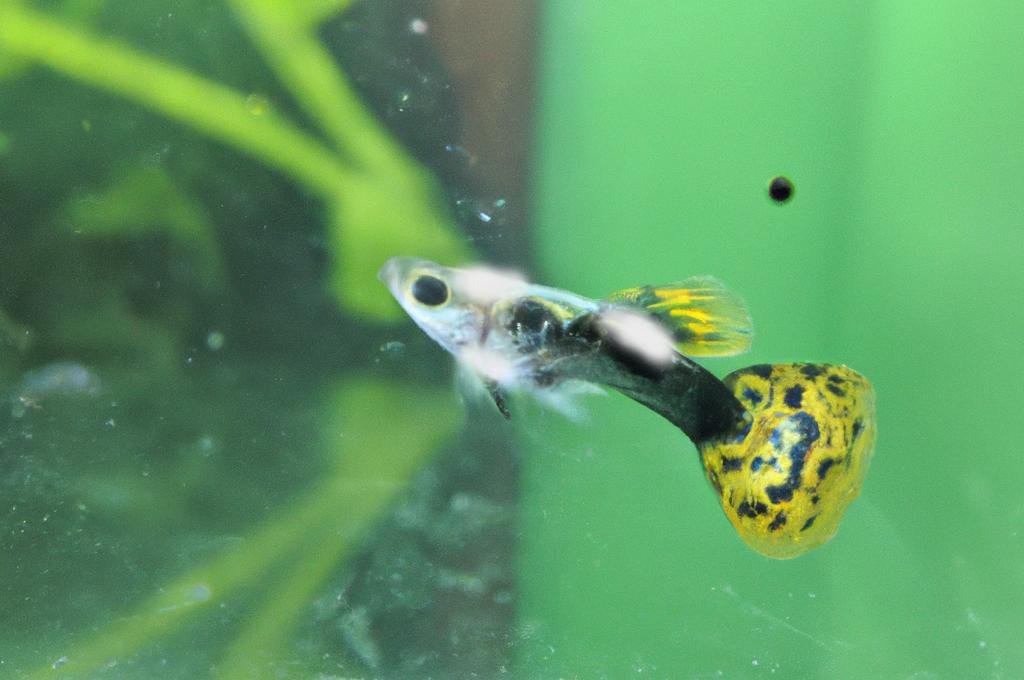
How To Treat Guppy Fungal Infections
There are a few different medications and treatments you can use to treat guppy fungal infections. The most common treatment is to use a medication called methylene blue. Methylene blue is a broad-spectrum antifungal that is effective against many different types of fungi.
Other treatment options:
- Malachite green – A broad-spectrum antifungal that is effective against many different types of fungi.
- Potassium permanganate- A strong oxidizing agent that can be used to kill fungi and other parasites.
- Aquarium salt- A natural antifungal that can be used to treat mild fungal infections.
How To Prevent Guppy Fungal Infections
Fungal infections in guppies are typically caused by the presence of opportunistic fungi.
They thrive in guppy tanks with poor water quality, inadequate filtration, high levels of organic waste, and stress-inducing conditions, making the fish more susceptible to infections.
Maintain Clean Water Conditions
- Perform regular water changes. This is the most important thing you can do to keep your tank water clean and healthy for your fish. Aim to change 25% of the water every week or two, depending on the size of your tank and the number of fish.
- Use a good filter system. A filter helps to remove waste products and debris from the water, and it also provides oxygen to the fish. Make sure to clean your filter regularly according to the manufacturer’s instructions.
- Don’t overfeed your fish. Uneaten food can decompose and pollute the water. Feed your fish only as much food as they can eat in 2 minutes, and remove any uneaten food after that time.
- Test your water regularly. This will help you to identify any potential problems with the water quality early on. You can test your water for pH, ammonia, nitrite, nitrate, and other important parameters.
Avoid Overcrowding
When a tank is overcrowded, there is less water per fish, which can lead to increased levels of ammonia and nitrite. These chemicals are toxic to fish and can weaken their immune systems, making them more susceptible to fungal infections.
In addition, overcrowding can make it difficult for fish to swim and exercise, which can also lead to health problems. When your guppies are stressed, their immune systems are weakened, making them more susceptible to fungal infections.
Finally, overcrowding can make it difficult to maintain good water quality in the tank. This can lead to a buildup of waste products and toxins, which can also weaken fish’s immune systems and make them more susceptible to fungal infections.
Provide Proper Nutrition
- Offer a mix of high-quality flakes, pellets, and live or frozen foods to provide a varied nutritional profile.
- Incorporate different types of live or frozen treats like brine shrimp, daphnia, or bloodworms to mimic their natural feeding behaviors.
- Consider adding vegetables like blanched spinach, peas, or zucchini as occasional treats to provide additional nutrients and fiber.
15) Guppy Disease - Popeye
Medium
How common is the issue
Bacterial Infections
What causes the illness
How To Identify Guppy Bacterial Infections
- Swollen or bulging eyes, cloudiness or redness in the affected eye, and reduced vision.

How To Treat Guppy Popeye
There are a few different medications and treatments you can use to treat guppy popeye. The most common treatment is to use a broad-spectrum antibiotic, such as erythromycin or kanamycin. You can get these antibiotics from most pet stores or online.
Other treatment options:
- Epsom salt baths: Dissolve 1 tablespoon of Epsom salt in 1 gallon of water and place the guppy in the salt bath for 5-10 minutes, then return it to the main tank.
- Aquarium salt: Add 1 teaspoon of aquarium salt per 5 gallons of water to the main tank.
Please note: It is important to follow the instructions on the medication label carefully. Some medications may require multiple doses or water changes.
Additional tips:
- Feed your guppy a high-quality diet to help them stay healthy.
- Maintain good water quality by performing regular water changes.
- Quarantine any new fish before adding them to your main tank.
If you are unsure which treatment is best for your guppy, it is always best to consult with a veterinarian or experienced aquarist.
Note: If the popeye is severe, you may need to treat the guppy in a separate quarantine tank. This will help to prevent the spread of the infection to other fish in your main tank.
How To Prevent Guppy Popeye
Popeye in guppies is typically caused by a bacterial infection.
Poor water quality, stress, and compromised immune systems can contribute to the development of popeye in guppies.
Maintain Clean Water Conditions
There are a few things you can do to keep the water levels in your guppy tank in optimal condition. I like:
Regular water changes remove waste products and toxins from the water, and help to prevent algae growth.
Using a good filter system that traps debris and waste particles, and provides oxygen to the water. Your filter should also have a biofilter that helps keep the water fresh with positive bacteria/
Feeding your fish only as much food as they can eat in 2 minutes prevents uneaten food from decomposing and polluting the water.
Testing your water regularly allows you to identify and address any potential problems with the water quality early on.
Avoid Physical Injuries
Physical injuries come from 2 places: bad decoration and aggressive tank mates.
To decorate your tank properly:
– Provide a well-planted and decorated environment with plenty of hiding spots to prevent guppies from colliding with hard surfaces or getting trapped.
– Avoid sharp or rough decorations that could potentially injure the fish.
To keep a peaceful tank:
– Monitor the behavior and interactions of the guppies to identify any signs of aggression.
-If necessary, separate aggressive individuals to prevent injuries to other tank mates.
Minimize Stress Levels
-
Provide hiding spots: Include plenty of plants, decorations, and caves in the tank to give your guppies places to retreat and feel secure.
-
Maintain stable water conditions: Keep water parameters within the appropriate range and avoid sudden fluctuations in temperature, pH, and water hardness.
-
Avoid overcrowding: Ensure sufficient space for your guppies by avoiding overstocking the tank.
-
Offer a varied diet: Provide a balanced diet with a variety of high-quality foods to meet their nutritional needs.
-
Minimize disturbances: Limit sudden loud noises, vibrations, and excessive handling around the tank to minimize stress.
16) Internal Parasites
Fairly Common
How common is the issue
Parasites/ Worms
What causes the illness
How To Identify Guppy Parasites
- Weight loss
- Decreased appetite.
- Abnormal feces.
- Distended abdomen
- Overall poor condition.

How To Treat Guppy Parasites
There are a few different medications and treatments you can use to treat guppy parasites. The most common treatment is to use a broad-spectrum antiparasitic, such as Levamisole or Praziquantel. You can get these medications from most pet stores or online.
Other treatment options:
- Fenbendazole
- Flubendazole
- Epsom salt baths: Dissolve 1 tablespoon of Epsom salt in 1 gallon of water and place the guppy in the salt bath for 5-10 minutes, then return it to the main tank.
- Aquarium salt: Add 1 teaspoon of aquarium salt per 5 gallons of water to the main tank.
Please note: It is important to follow the instructions on the medication label carefully. Some medications may require multiple doses or water changes.
Additional tips:
- Feed your guppy a high-quality diet to help them stay healthy.
- Maintain good water quality by performing regular water changes.
- Quarantine any new fish before adding them to your main tank.
How To Prevent Guppy Parasites
If you want to bring parasites into your tank, the only way it can happen is if you add plants or fish that are already infected.
That means that you need to be careful when you think about adding stuff from the wild to your tank.
The best way to avoid getting parasites in your tank is to make sure you only get your supplies and fish from suppliers you trust and who have a good reputation.
Quarantine New Fish
Quarantining new fish will help prevent A LOT of guppy diseases.
- Set up a quarantine tank that is separate from your main tank. The quarantine tank should be bare-bottom or have very few decorations to make it easy to clean and observe the fish.
- Acclimate the new fish to the quarantine tank water slowly over 30 minutes before releasing them into the tank.
- Observe the fish carefully for any signs of illness, such as lethargy, loss of appetite, flashing, or white spots on the body. If you notice any signs of illness, treat the fish immediately with the appropriate medication.
- Quarantine the new fish for at least four weeks, or longer if they show any signs of illness. Once the quarantine period is over and the fish are showing no signs of illness, they can be added to your main tank
Maintain Good Water Quality
Let’s dive into how to maintain great water quality in your guppy fish tank!
Firstly, test the water regularly using a reliable aquarium test kit to monitor parameters like ammonia, nitrite, nitrate, pH, and a thermometer for temperature.
Perform regular partial water changes, replacing about 20-30% of the water, to remove accumulated waste and toxins.
Don’t forget to clean the tank’s substrate, decorations, and filter media to prevent the buildup of organic matter.
Also, ensure proper filtration by regularly cleaning or replacing filter media to keep the water clean and clear.
Finally, avoid overfeeding your guppies, as uneaten food can contribute to water pollution
17) Guppy Constipation
Common
How common is the issue
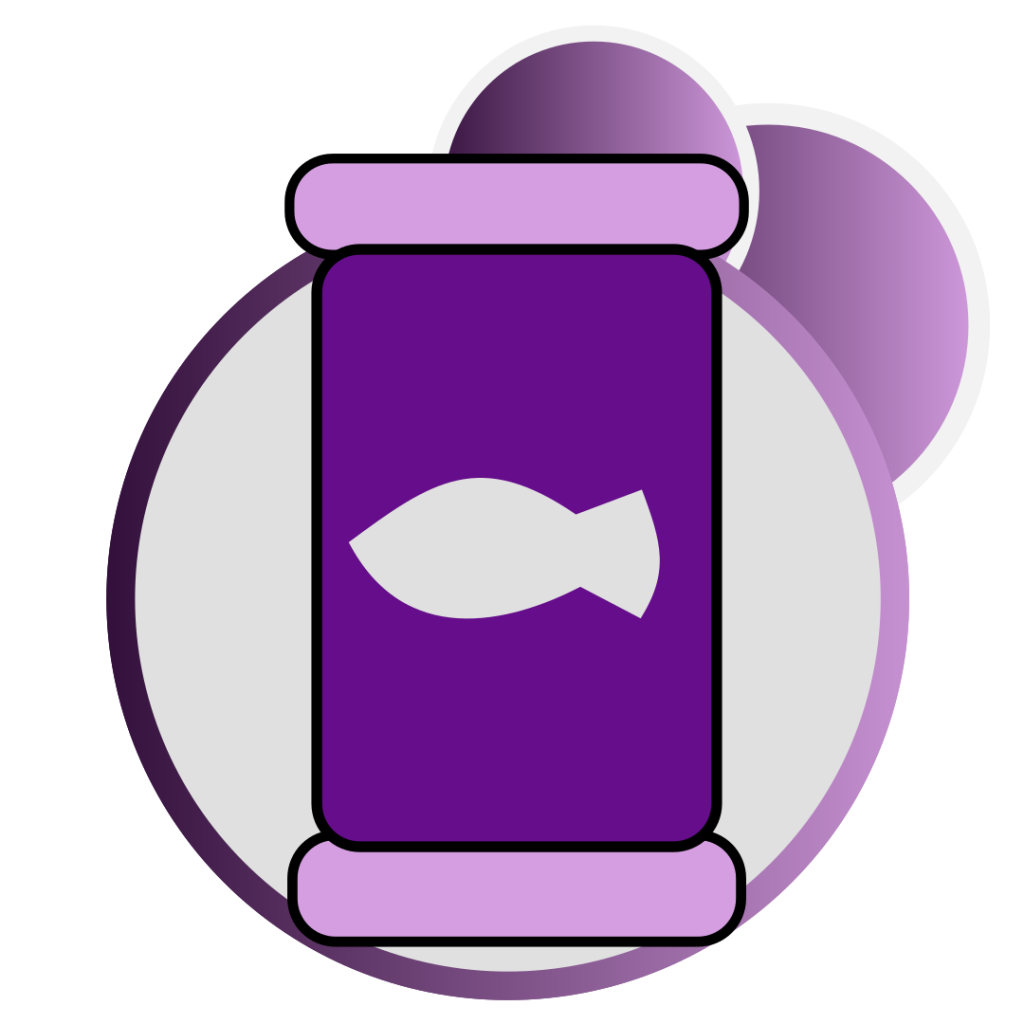
Dietary issues
What causes the illness
How To Identify Guppy Constipation
- Difficulty passing feces.
- Bloating
- Loss of appetite.
- Decreased activity.
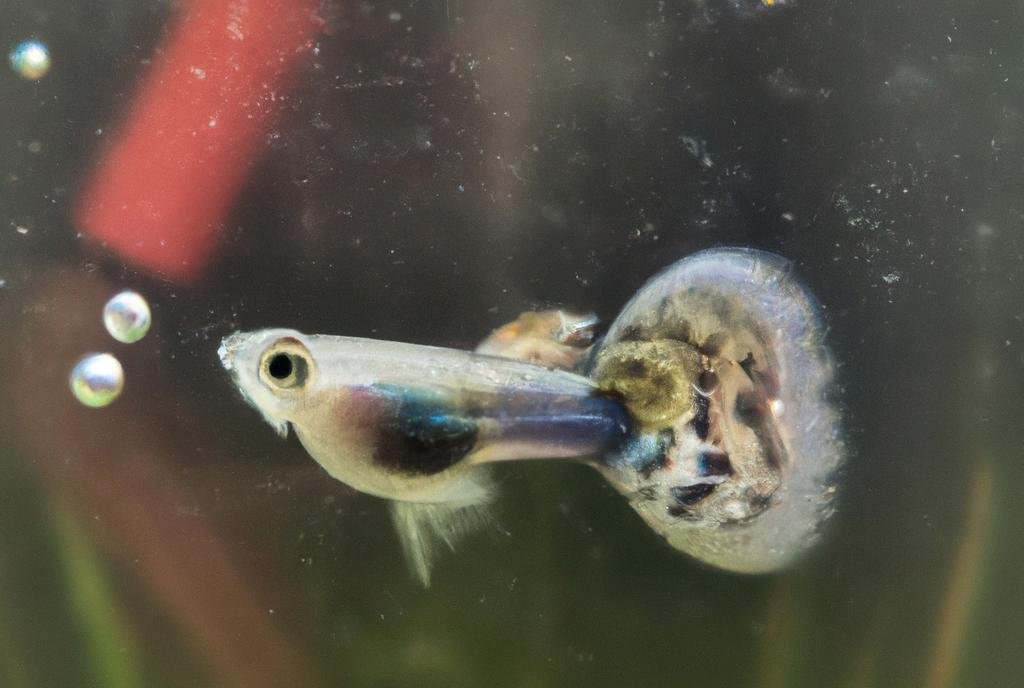
How To Treat Guppy Constipation
To treat constipation in guppies, you can start by fasting them for 24 to 48 hours, allowing their digestive system to reset.
After the fasting period, offer them fibrous foods like blanched peas or specially formulated guppy food to help relieve the constipation and promote regular bowel movements.
How To Prevent Guppy Constipation
Since constipation isn’t really a guppy disease it is usually caused by overfeeding or a diet lacking in fiber.
Be mindful of how much you feed your guppies and ensure their diet includes fibrous foods like blanched peas or specially formulated guppy food to help prevent constipation.
Provide a Varied Diet
Here are a few tips about providing a diverse diet to your guppies:
Mix up their main meals: Offer a combination of high-quality flakes and pellets specifically formulated for guppies. This provides essential nutrients and helps maintain their overall health.
Add some live or frozen treats: Treat your guppies to occasional live or frozen foods like brine shrimp, daphnia, or bloodworms. These provide additional protein and mimic their natural diet, satisfying their predatory instincts.
Include veggies for a balanced diet: Don’t forget about the greens! Offer blanched veggies like spinach, peas, or zucchini as a source of fiber and essential vitamins. It’s a great way to keep their diet diverse and promote overall well-being.
Avoid Overfeeding
Here’s why you shouldn’t go overboard with feeding your guppies!
Overfeeding can lead to waste buildup, leading to poor water quality, and potential health issues.
Plus, uneaten food can break down and pollute the tank, creating a mess and increasing the risk of bacterial or fungal growth.
It can also lead to bloating and a problem that requires fixing on its own.
Maintain Good Water Quality
Keeping the water quality in your guppy fish tank top-notch is vital for their well-being. Here are some easy tips to maintain good water quality:
Test the water regularly using a test kit to monitor ammonia, nitrite, nitrate, and pH levels. This helps you catch any issues early on.
Perform regular partial water changes of around 20-30% every one to two weeks to remove accumulated waste and toxins.
Clean the tank’s substrate, decorations, and filter media periodically to prevent the buildup of debris and organic matter.
Avoid overfeeding your guppies as excess food can lead to ammonia spikes. Feed them only what they can consume within a few minutes.
Invest in a reliable filtration system suitable for your tank size and maintain it properly by cleaning or replacing filter media as needed.
Remember, maintaining good water quality is key to your guppies health.
18) Ammonia Burns
Common
How common is the issue
Toxin Poisoning
What causes the illness
How To Identify
- Red or inflamed gills
- Rapid or labored breathing
- Lethargy
- Loss of appetite.

How To Treat Guppy Ammonia Poisoning
To treat ammonia poisoning in a guppy tank, the first step is to immediately perform a partial water change to dilute the ammonia levels.
Then you need to look at your filter. Your filter is the first line of defense against ammonia. Make sure it works properly and isn’t clogged. You need to clean your filter once a month and replace the biofilter at the same rate.
You can also use a siphon pump to vacuum debris off the bottom. You don’t have to replace the water along with it- just pick up whatever is on the bottom so it doesn’t rot and release ammonia.
How To Prevent Guppy Ammonia Poisoning
Ammonia in a guppy tank is primarily caused by the buildup of fish waste, uneaten food, and decaying organic matter. It’s not much of a guppy disease as much as it’s a sign of an uncycled tank.
It is important to regularly maintain the tank, perform partial water changes, and ensure proper filtration to prevent ammonia levels from becoming harmful to the guppies.
Maintain Good Filtration
Remember to clean or replace the filter media regularly to prevent clogs and maintain efficient filtration.
Also, keep an eye on the water flow and make adjustments to ensure proper circulation.
As a rule of thumb, the pump should be able to move the entire tank 6 times an hour.
That means that a 10-gallon tank will call for a 60-gallon per hour (GPH) pump.
Perform Regular Water Changes
let’s talk about the importance of regular water changes in your guppy fish tank.
It’s a key part of keeping their environment clean and healthy.
Aim for weekly or bi-weekly water changes, removing about 20-30% of the tank’s water and replacing it with fresh, treated water.
This helps remove accumulated toxins, maintain optimal water quality, and keeps your guppies swimming happily.
Avoid Overstocking
Research suitable stocking guidelines: Understand the recommended number of guppies based on tank size, filtration capacity, and the specific needs of the fish. This helps you determine an appropriate stocking level and prevent overcrowding.
Consider adult size and growth potential: Take into account the adult size of guppies and their growth potential when planning the number of fish for your tank. This helps prevent the tank from becoming overcrowded as the fish grow.
Monitor behavior and water parameters: Observe the behavior of your guppies and regularly test water parameters to ensure a healthy and stress-free environment. If you notice signs of stress, aggression, or declining water quality, it may be an indication of overstocking. Adjust the fish population accordingly to maintain a balanced and thriving tank.
19) Stress-Related Diseases
Common
How common is the issue
Various Stressors
What causes the illness
How To Identify Stress in Guppies
- Loss of appetite
- Color fading
- Erratic swimming
- Increased susceptibility to diseases.

How To Treat Stress In Guppies
Maintain stable water conditions, minimize stressors, and provide appropriate hiding places.
How To Prevent Stress In Guppies
Stress opens the door to pretty much any guppy disease out there. Even parasites, that have to already be in the water, can’t really take a toll until your fish’s immune systems gets weak enough- due to stress.
Stress Reducers
Provide hiding spots: Include plenty of plants, decorations, and caves in the tank to give your guppies places to retreat and feel secure. This helps reduce stress caused by constant exposure.
Maintain stable water conditions: Keep water parameters within the appropriate range and avoid sudden fluctuations in temperature, pH, and water hardness. Consistency in water conditions helps guppies adapt and reduces stress.
Avoid overcrowding: Ensure sufficient space for your guppies by avoiding overstocking the tank. Overcrowding can lead to increased competition, aggression, and stress. Follow recommended stocking guidelines for a harmonious environment.
Offer a varied diet: Provide a balanced diet with a variety of high-quality foods to meet their nutritional needs. This helps prevent nutritional deficiencies and promotes overall health, reducing stress levels.
Minimize disturbances: Limit sudden loud noises, vibrations, and excessive handling around the tank to minimize stress. Guppies are sensitive to their surroundings, and a calm environment promotes their well-being.
Good Water Qaulity
Let’s dive into how to maintain great water quality in your guppy fish tank!
Firstly, test the water regularly using a reliable aquarium test kit to monitor parameters like ammonia, nitrite, nitrate, pH, and a thermometer for temperature.
Perform regular partial water changes, replacing about 20-30% of the water, to remove accumulated waste and toxins.
Don’t forget to clean the tank’s substrate, decorations, and filter media to prevent the buildup of organic matter.
Also, ensure proper filtration by regularly cleaning or replacing filter media to keep the water clean and clear.
Finally, avoid overfeeding your guppies, as uneaten food can contribute to water pollution
Can't Find Your Guppy Disease?
Ask An Expert- Free
Please send us an email and we’ll have an expert take a look. Please include as many pictures as possible to help us accurately identify the condition.
